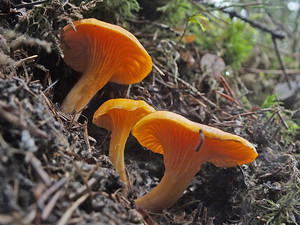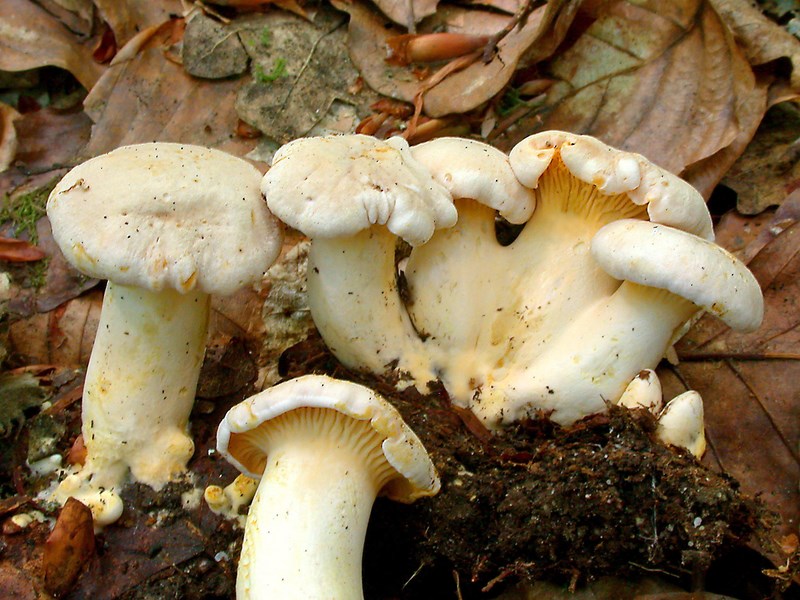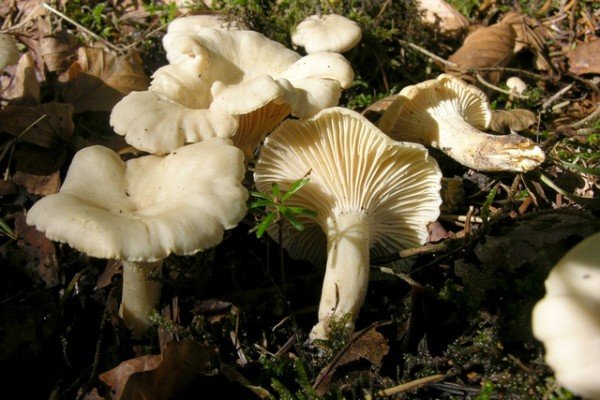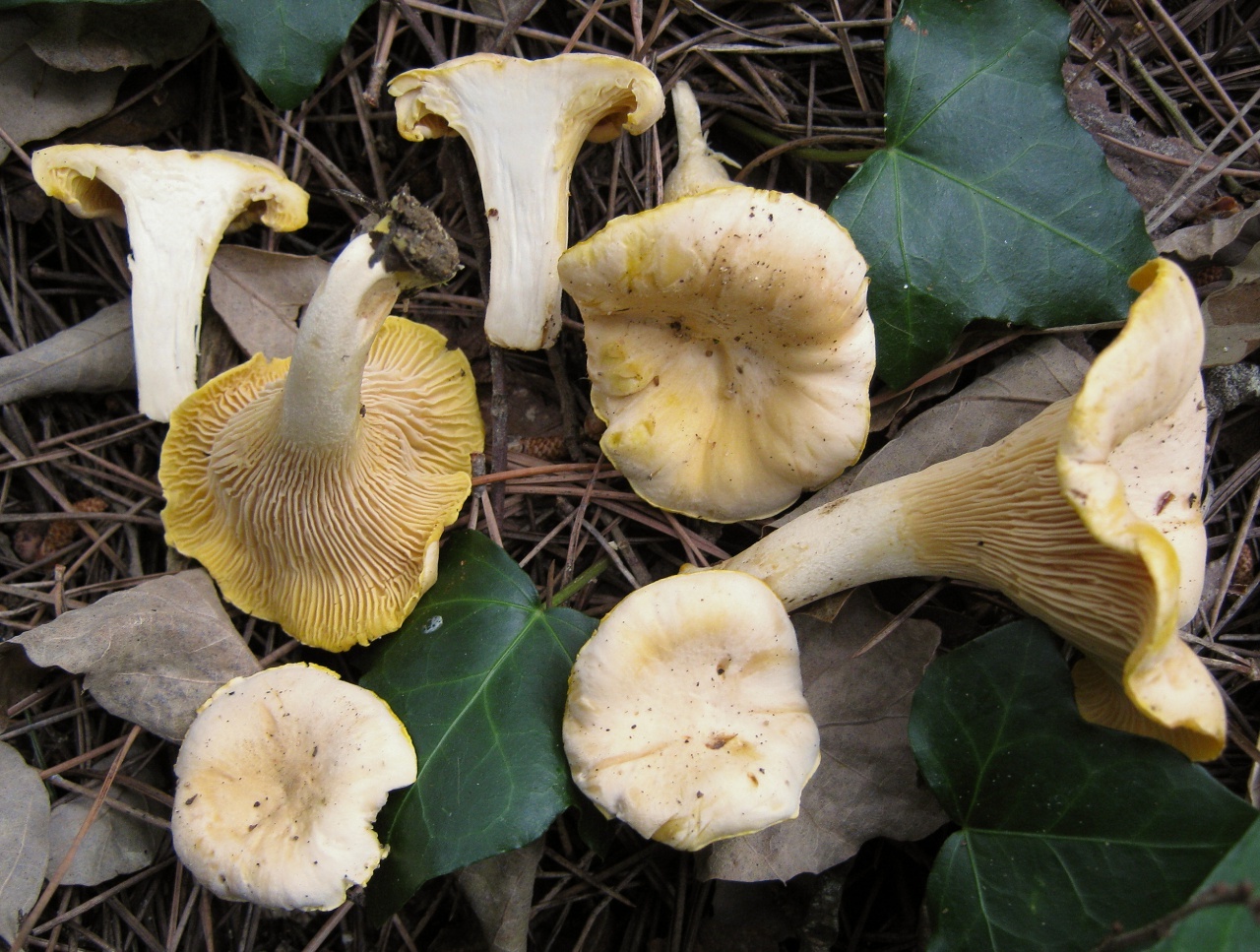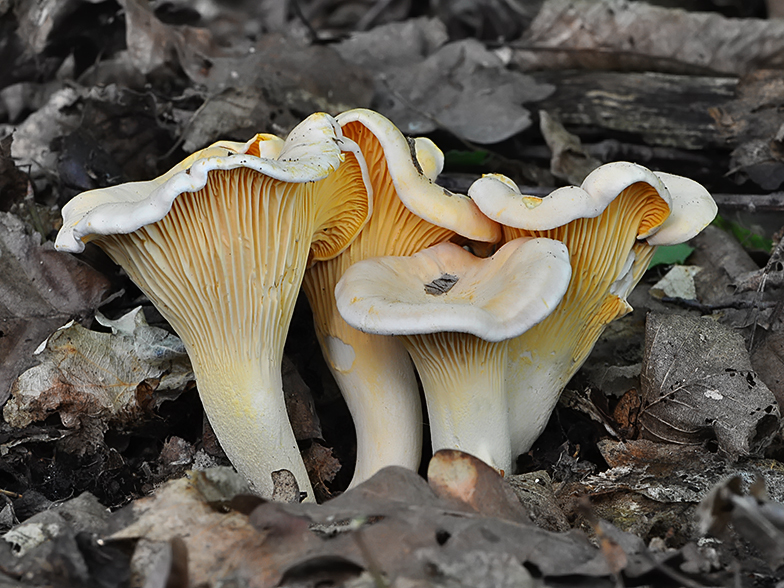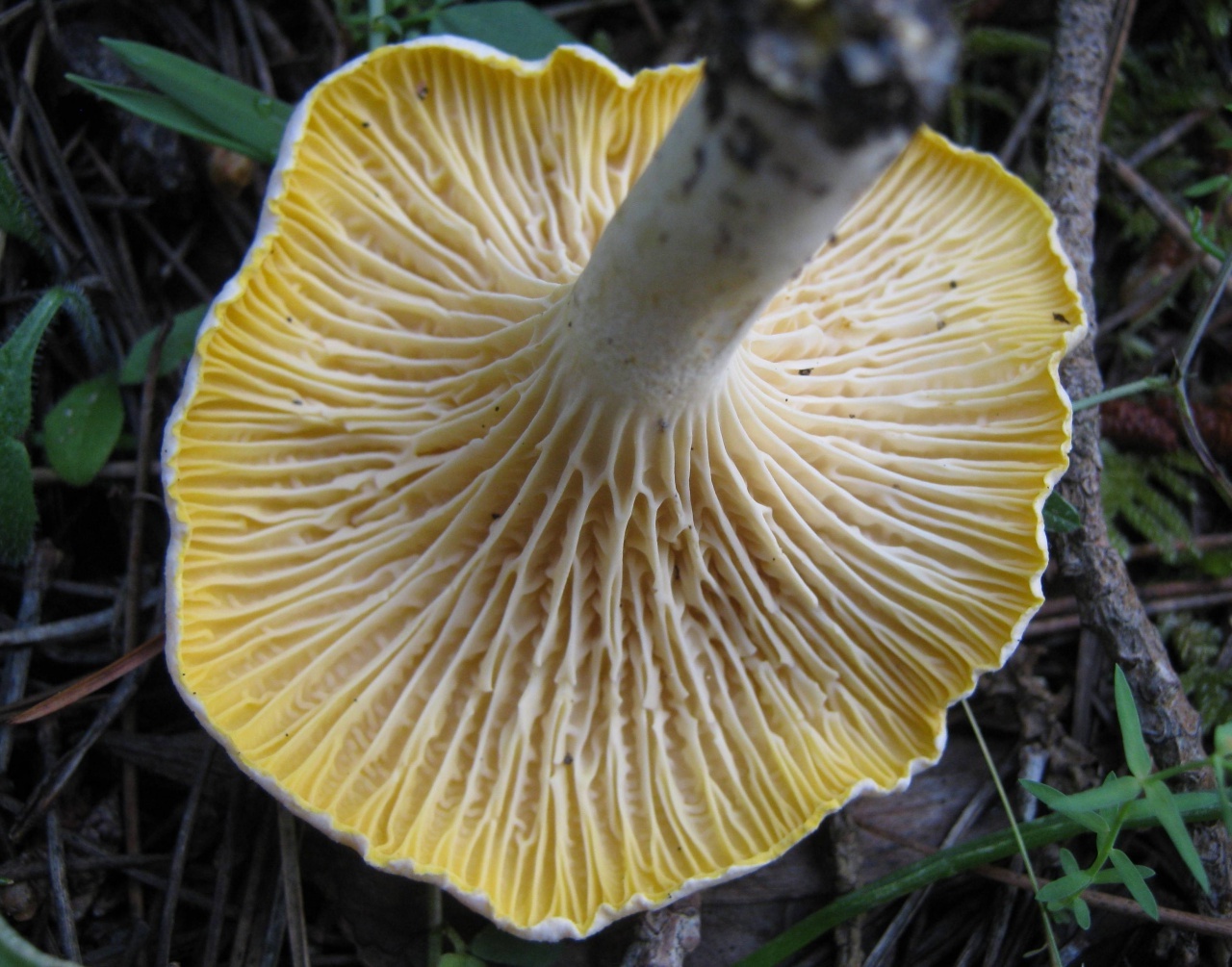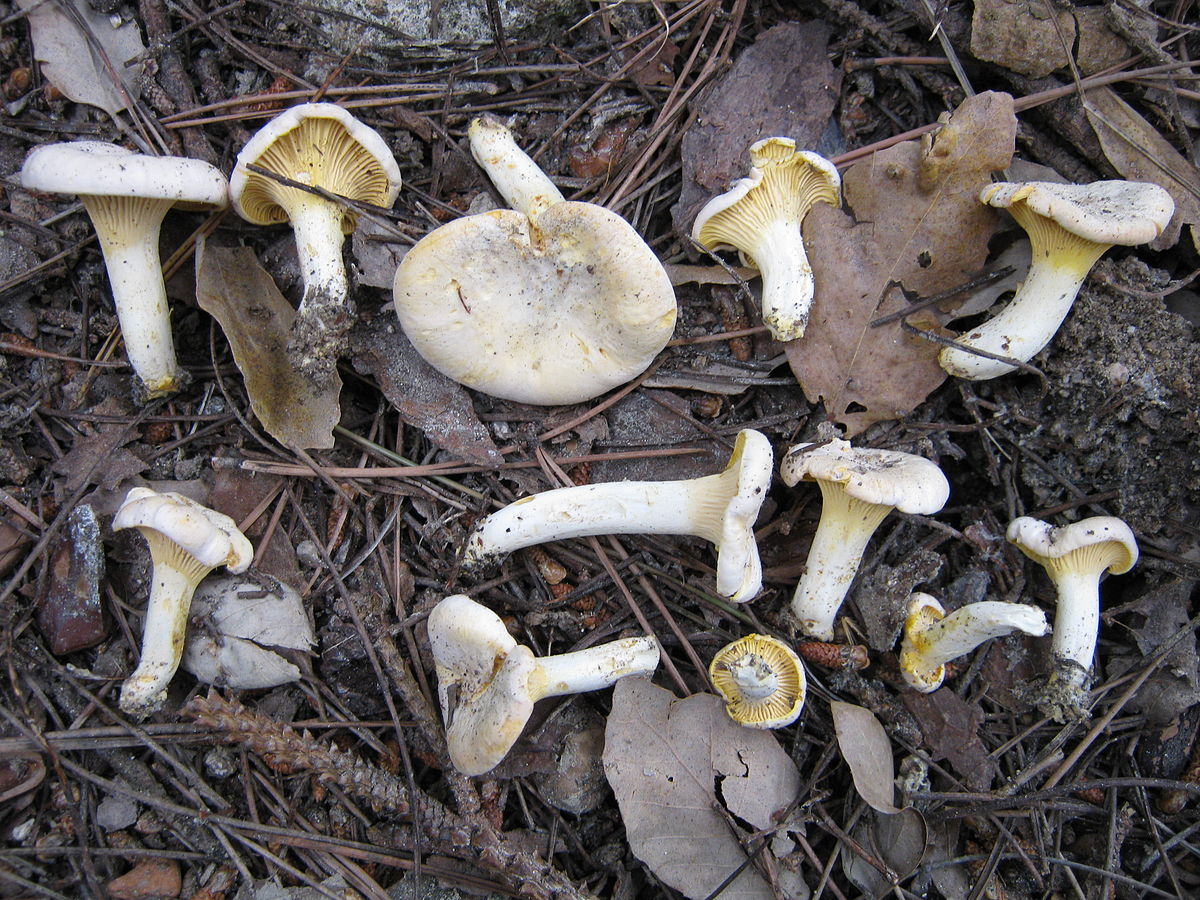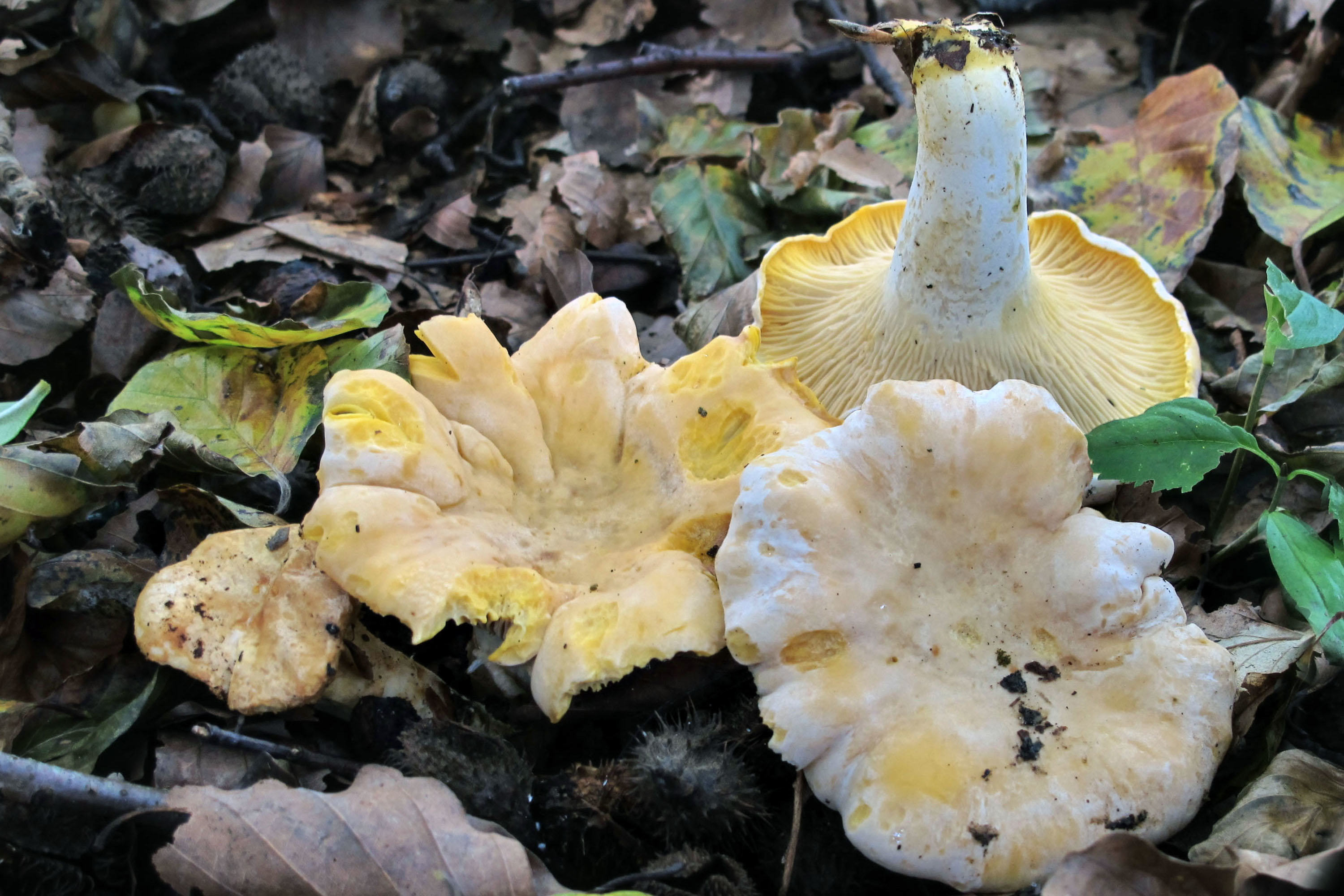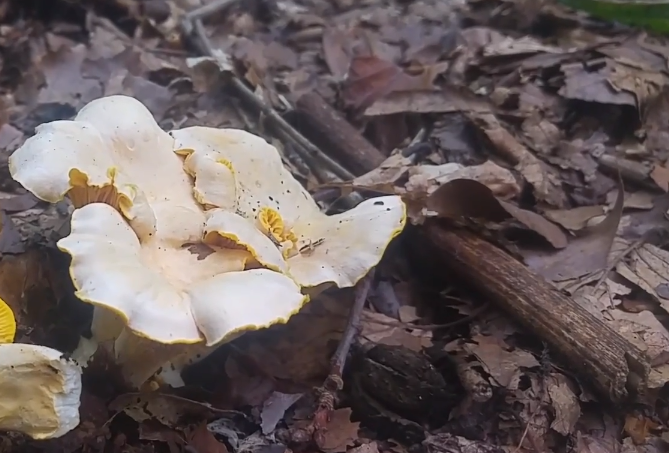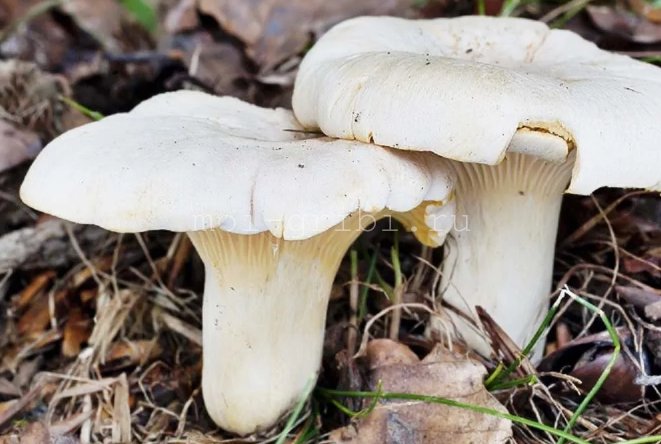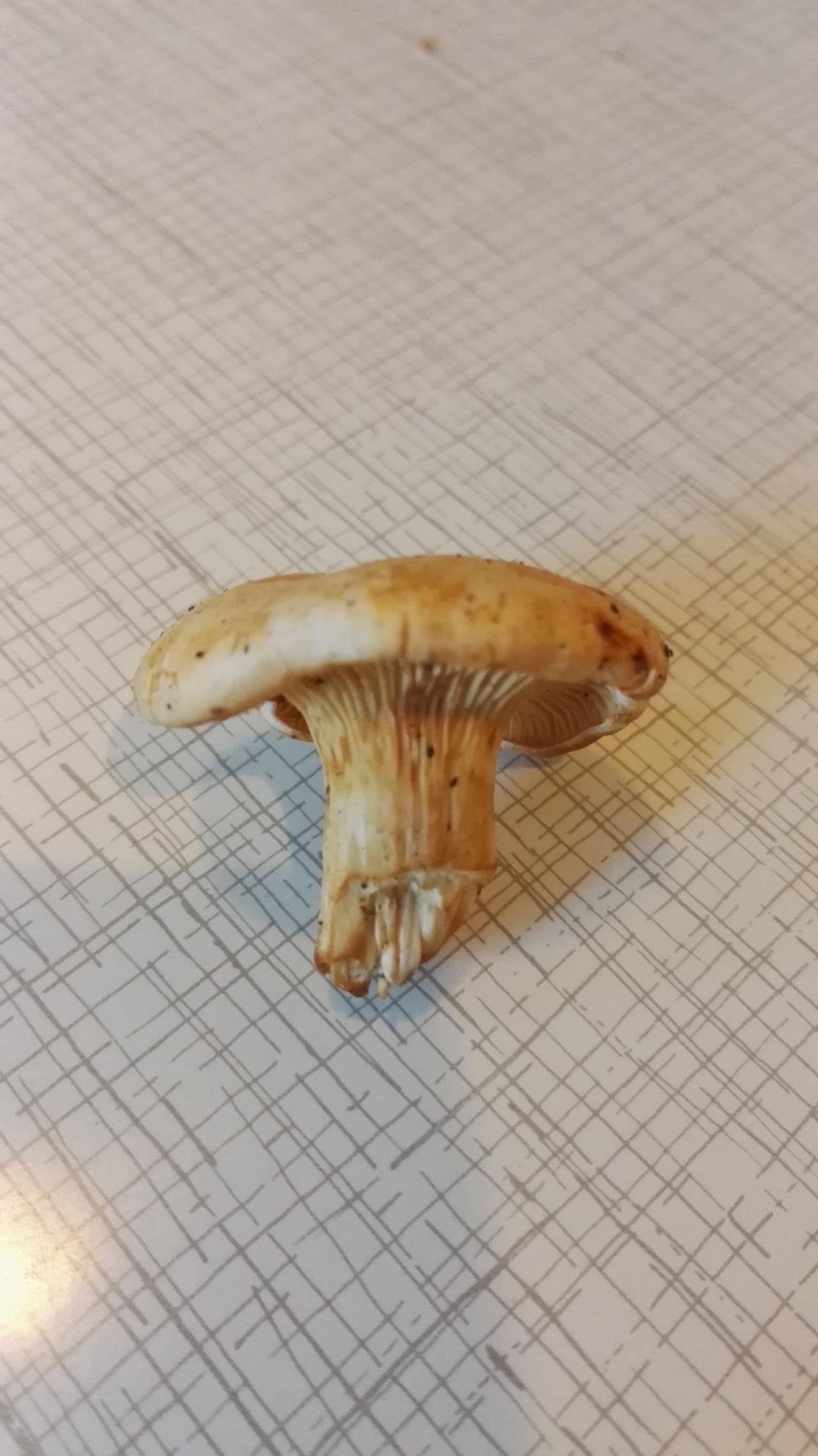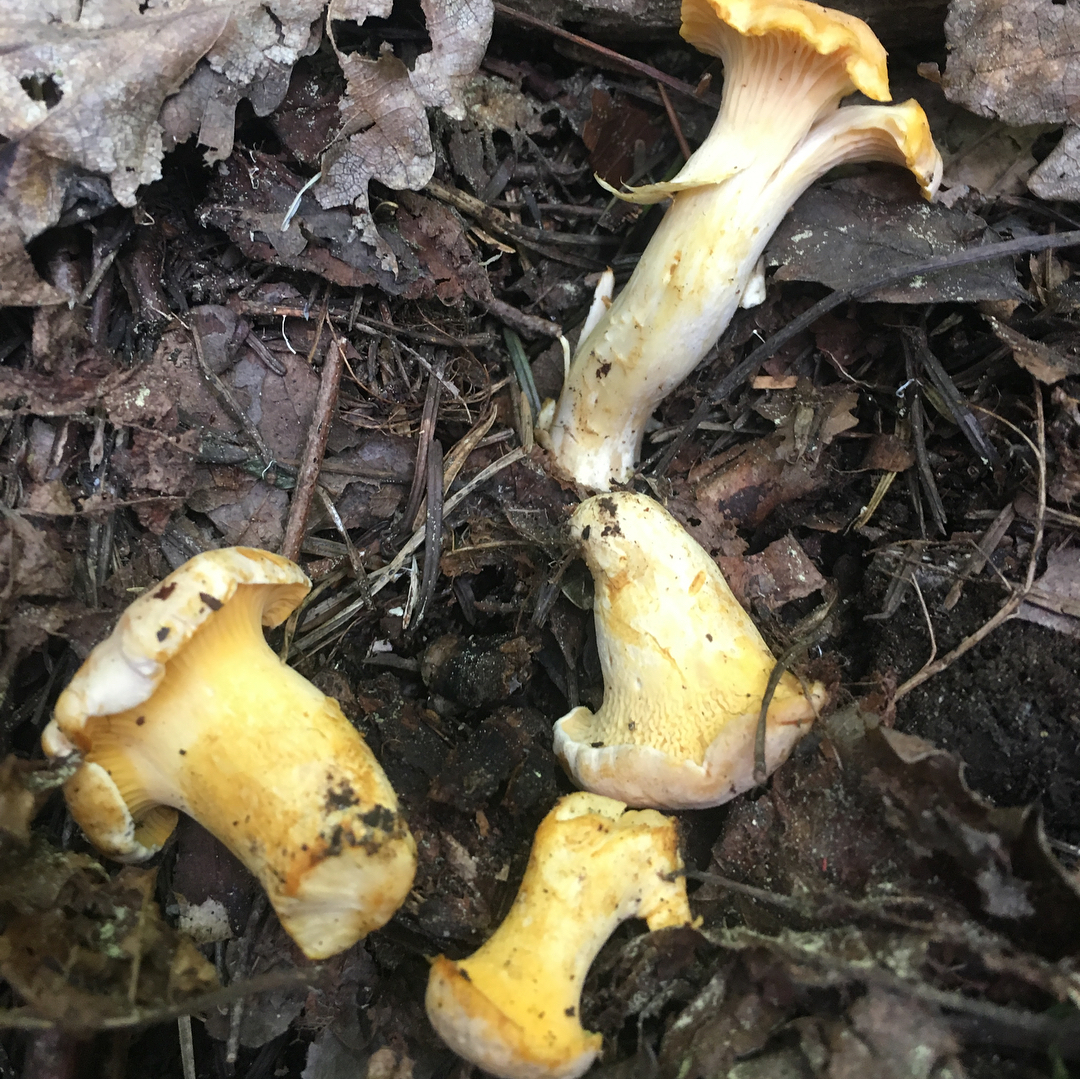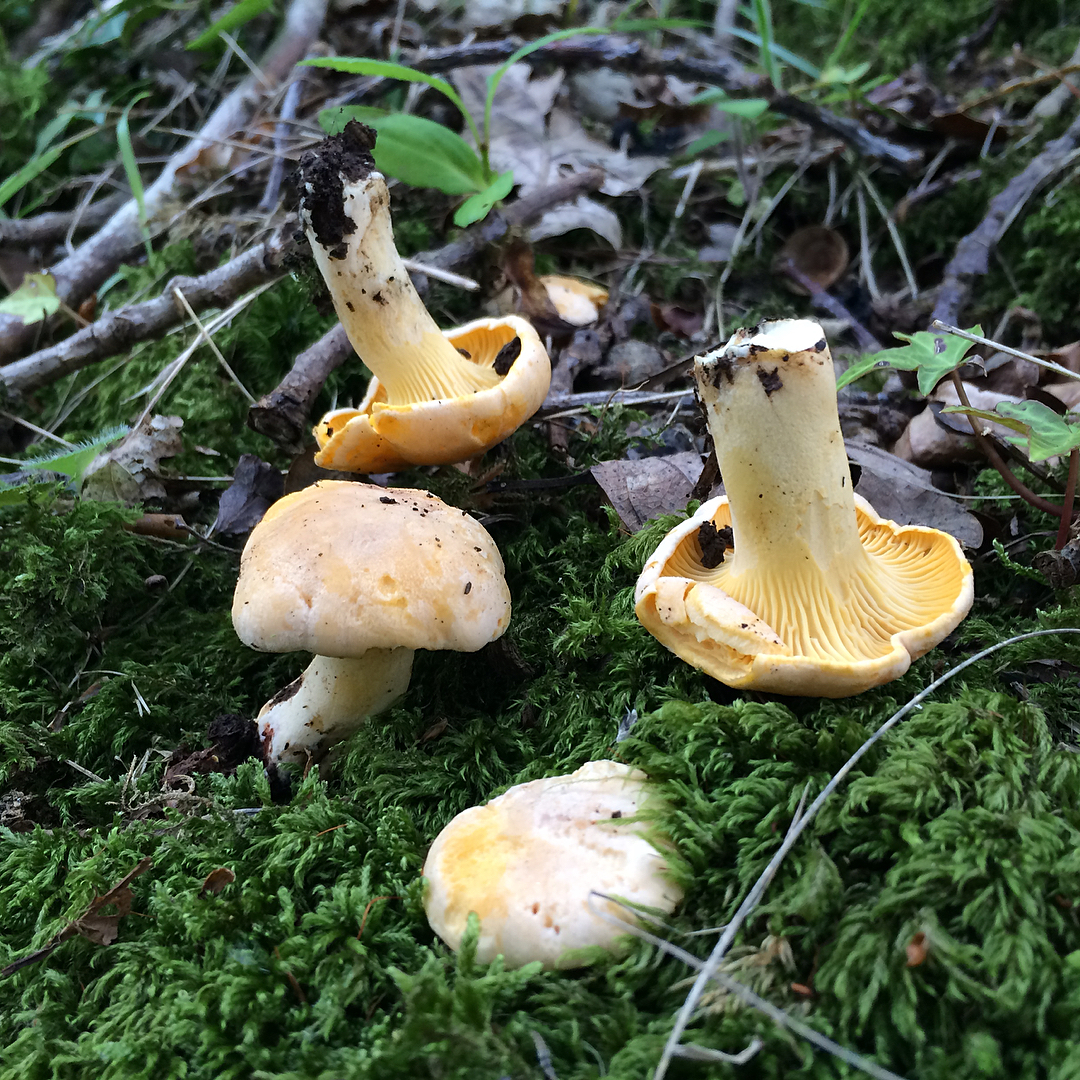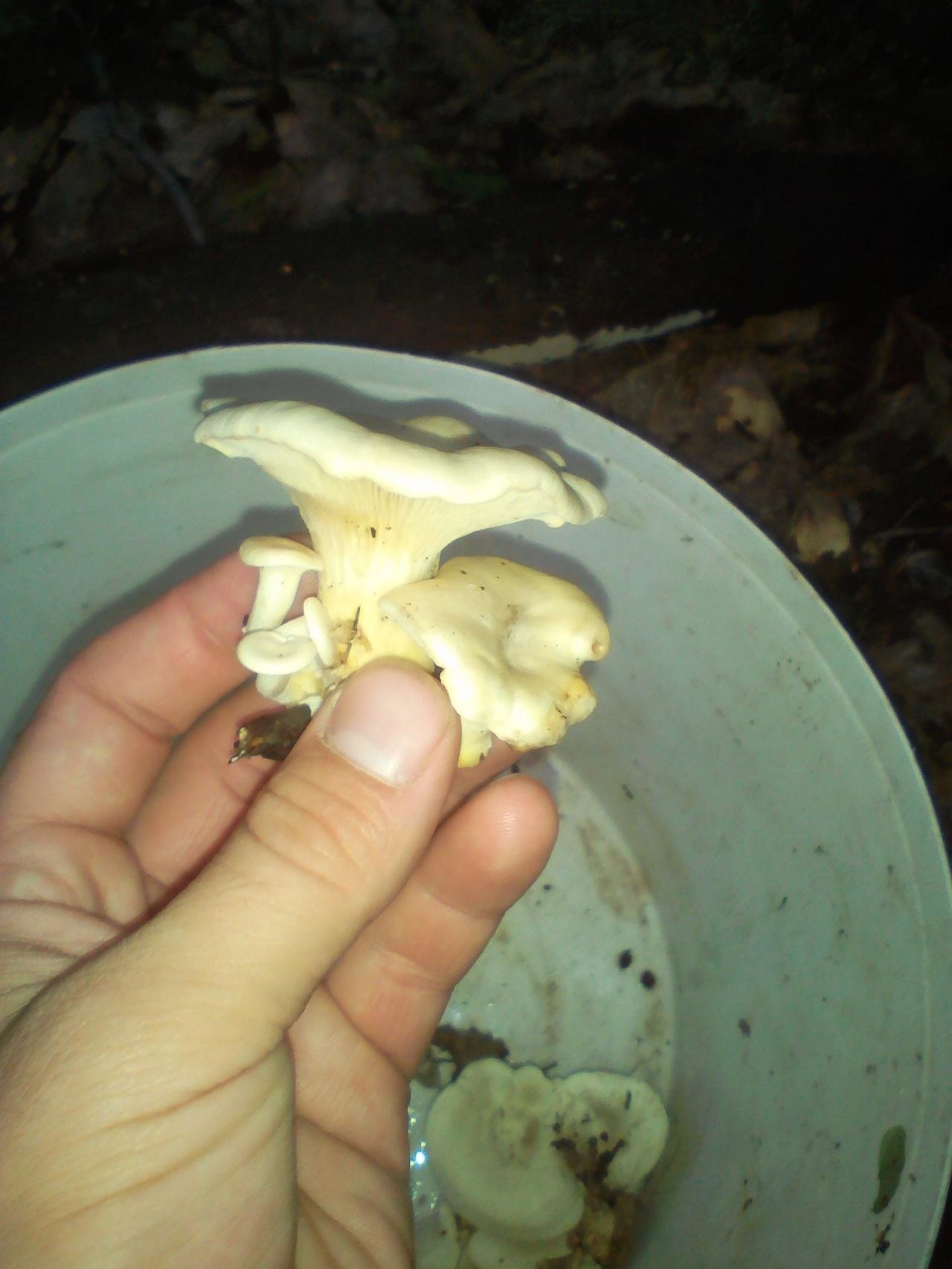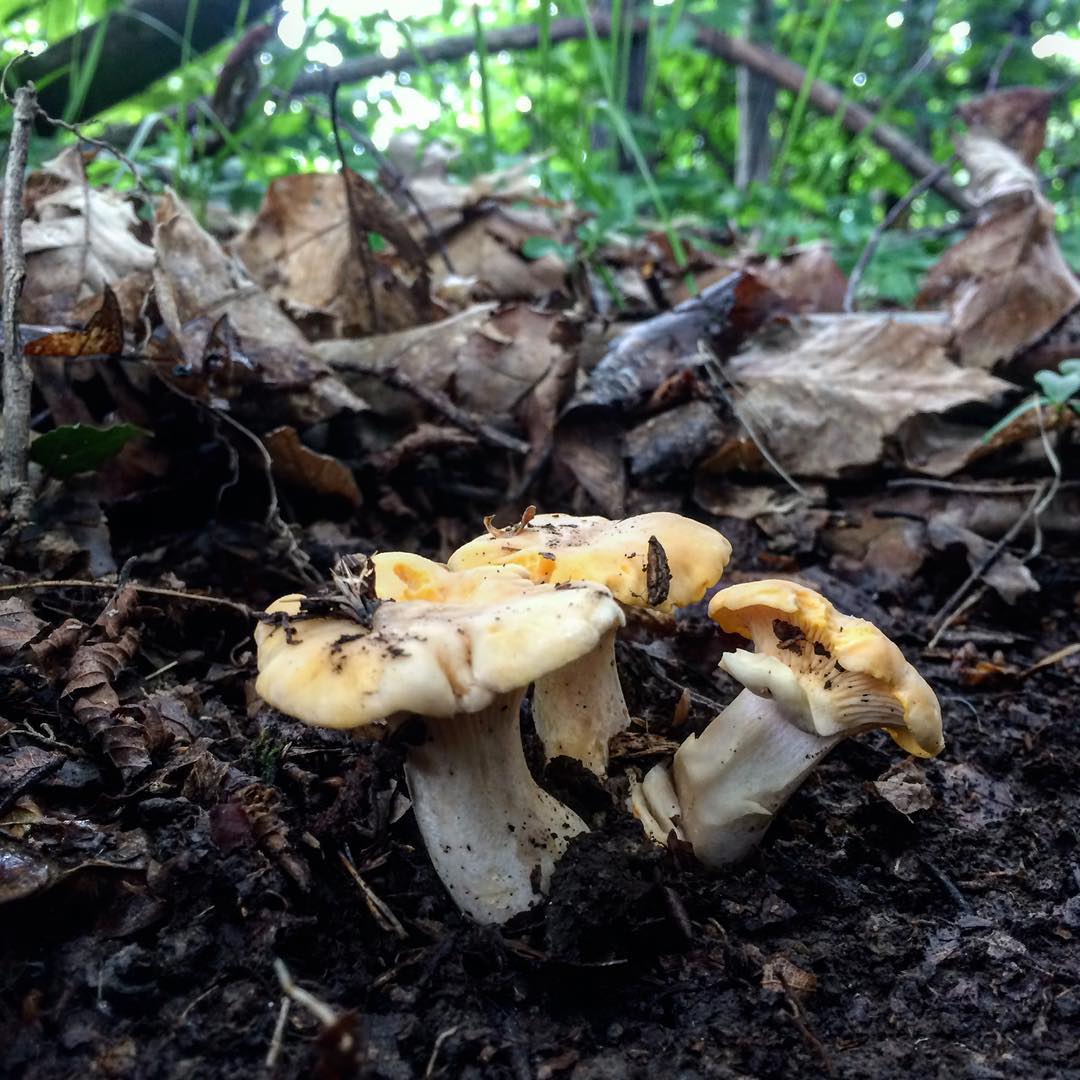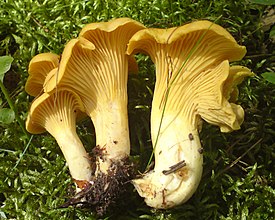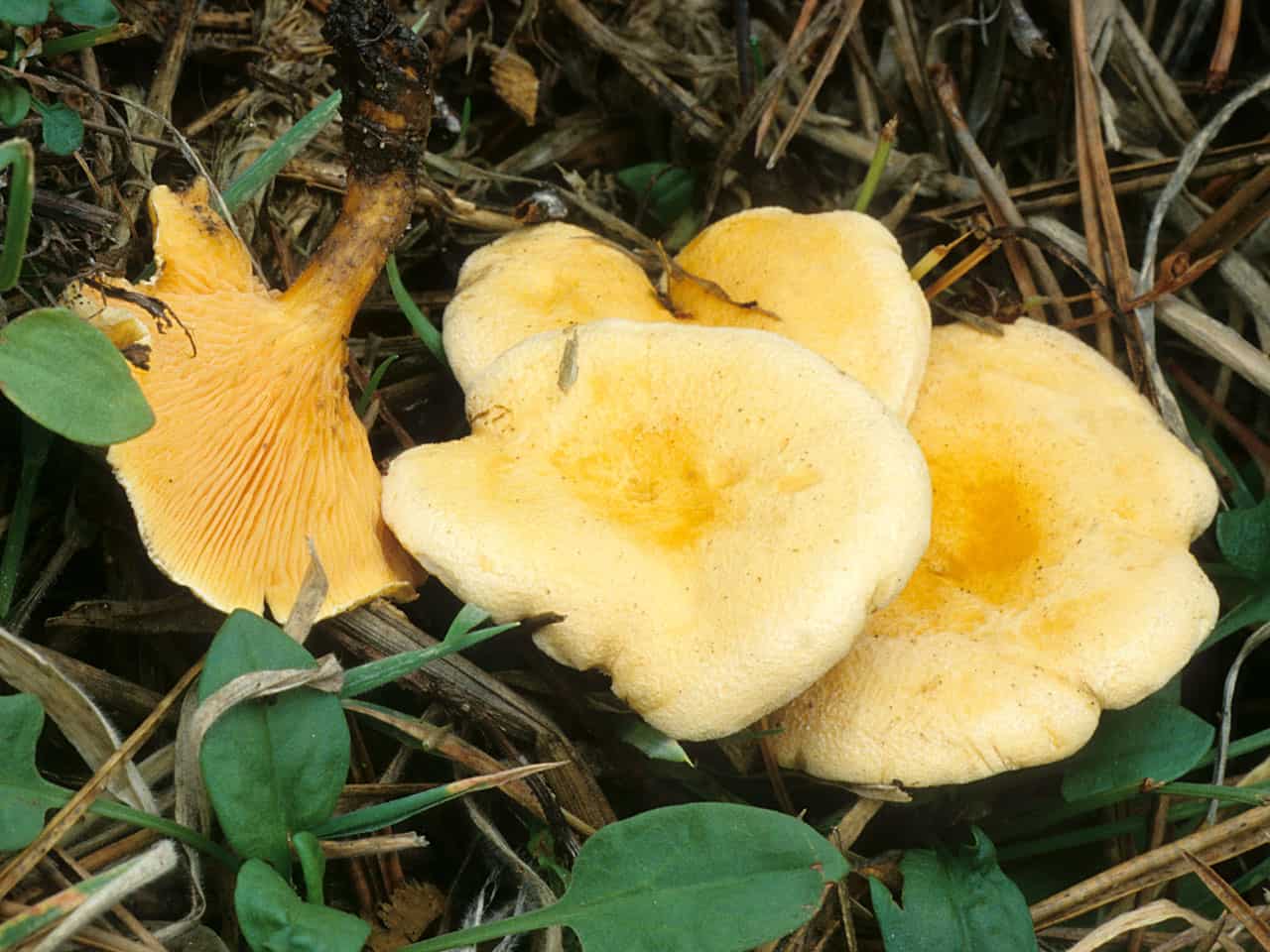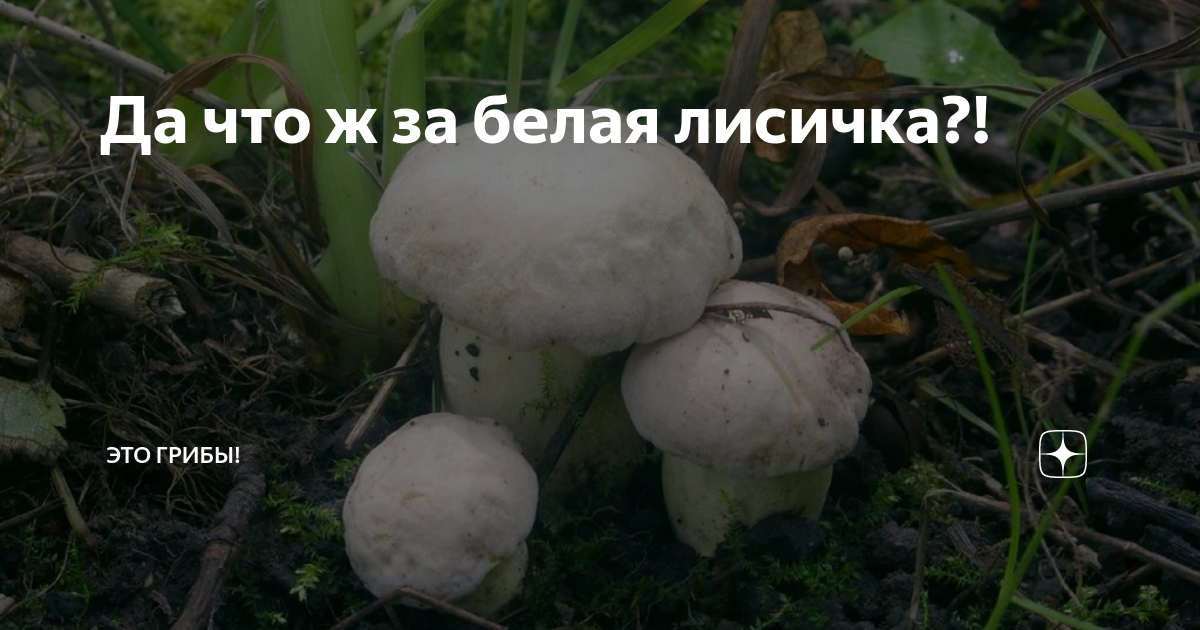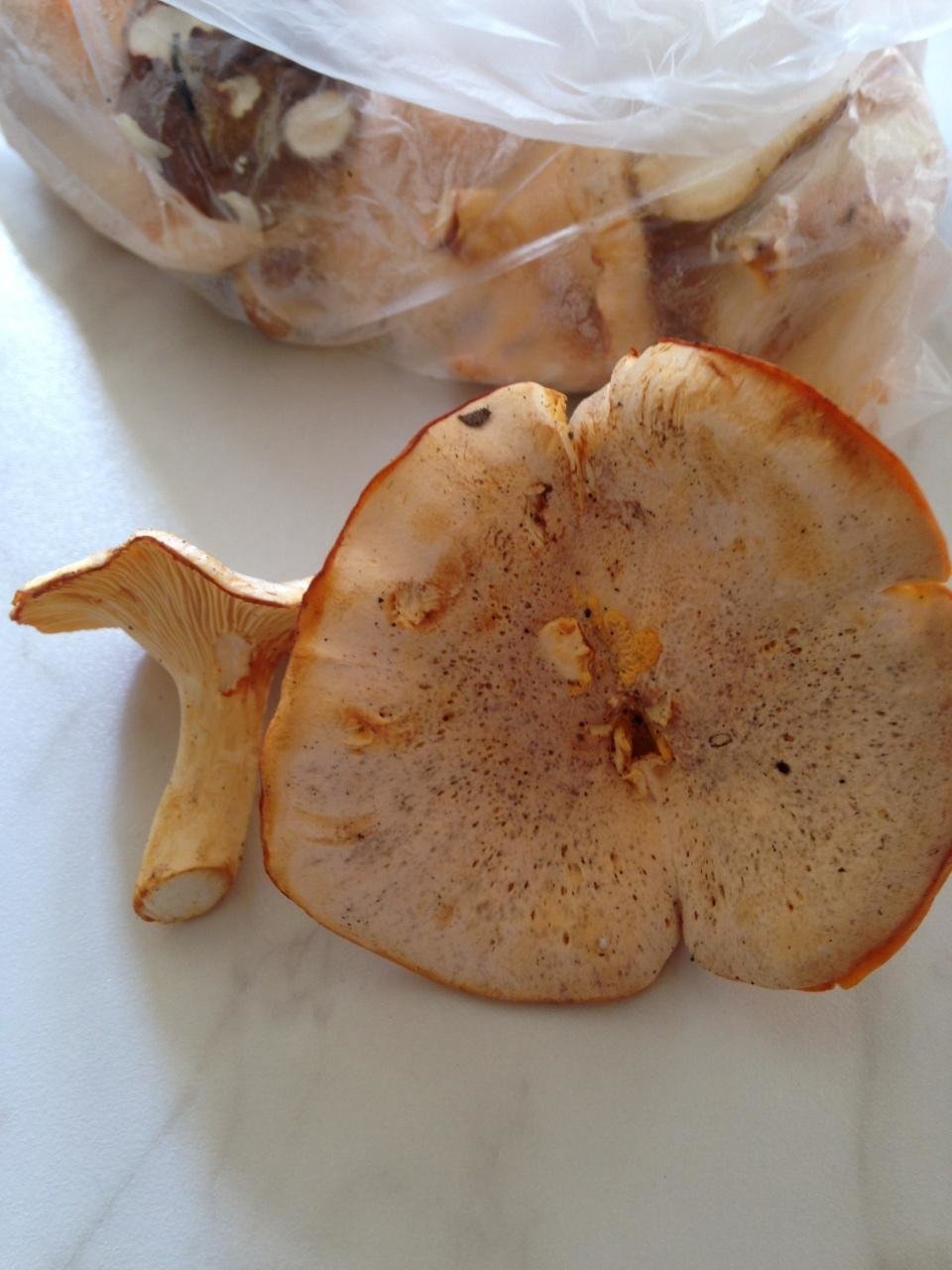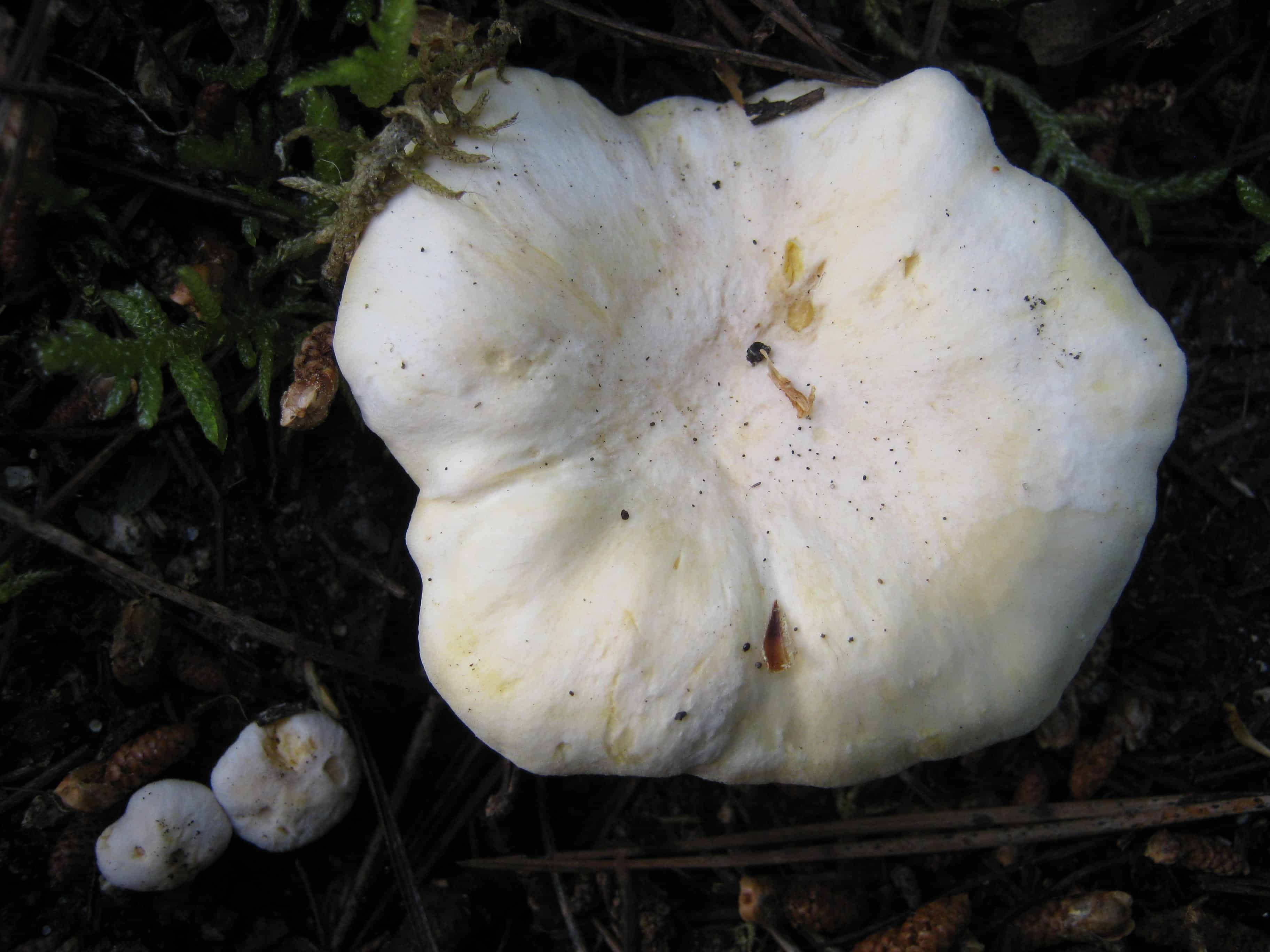Collection rules
Although edible, white chanterelles should not be eaten if they have been improperly collected or in the wrong place. Do not collect them near industrial areas, as they accumulate heavy metals and other harmful substances. For the same reason, they are not collected near roads or highways.
So, it is clear that you need to collect in clean forests.
And first of all, you need to pay attention to the state of the mushroom. Edible white fruit is never wormy
This is due to the fact that its pulp is poisonous for worms and other parasites, but absolutely safe for humans.
In order not to be mistaken when collecting a white chanterelle, it is recommended to watch a video that clearly shows how it looks.
White chanterelles grow in summer, but in autumn they can also be found in mixed forests. Mass collection falls on the summer months: June, July, August. Of course, in September and October they can also be collected, but not so many. During the period of heavy rains, they do not rot, but retain their previous appearance. But on dry days they stop growing.
To collect a lot of white chanterelles, you have to work hard. After all, they love to hide under the needles, fallen leaves. But if at least one mushroom is found, then there will definitely be more nearby, you just need to carefully examine the place. They grow in groups, sometimes forming large glades.
High-quality, suitable for collection, white fruits do not have any damage, mold or bloom, various spots on the caps. You do not need to take fruiting bodies if they are sluggish, soft, dry.
How to distinguish
A real mushroom from a natural twin can be easily distinguished by visually and tactile characteristics. To do this, follow these steps:
- Take a mushroom, look at its cap - first at the central part, then along the edges.
- Go down below, examine the structure of the mushroom plates, touch them.
- Cut the mushroom a little to the pulp, smell and touch it, and then press lightly and watch the color change.
- Look at the shape of the stem of the mushroom.
Hat
The false mushroom has a brighter and more saturated cap color than the real one, and a velvety shade of the surface. It is mainly orange, sometimes there are specimens with a brown edging, and the edges are lighter than the central part of the cap. The real mushroom has a rich color palette of the cap from light yellow to yellow-orange. At the same time, the color of a real chanterelle is uniform, that is, the edges have the same color as the center of the cap.
The orange talker is endowed with a large cap with a diameter of 15 to 60 cm and rounded, even and smooth edges, which in adults becomes funnel-shaped, and in young ones it has a convex shape. The cap of a real chanterelle is no more than 12 cm in diameter and has irregular wavy edges. As it develops, there is a gradual change in the cap at a young age, it is slightly convex, then it becomes flatish, and then a little depressed. Older chanterelles are completely funnel-shaped with downward-curved edges.
Mushroom plates
The talker has thin bright red plates, often branching, which go down to the leg, but do not pass into it. Real chanterelles have thick and dense plates that go down the stem and smoothly move along the trunk. Disputes differ only in color, in doubles they are white, and in real ones they are yellow.
- How can you replace the risen ginger
- Pension with a salary of 30,000 rubles
- Divorce of pensioners by phone allegedly from the Pension Fund
Mushroom pulp
The pulp of the false mushroom is yellow in color, has a loose consistency and exudes a fetid odor. When pressed, its color remains unchanged. The consistency of the pulp of a real chanterelle is dense with a two-tone color.Its central part is white and yellowish towards the edges. When pressed, there is a smooth, slight color change to a pale red. Has a sour taste, exudes a pleasant aroma.
Leg
The false mushroom has an orange-reddish thin cylindrical stalk that darkens closer to the ground. In the section inside an adult, the leg is hollow, while a certain border can be traced that clearly separates it from the cap. A real chanterelle has not a hollow, compacted leg, is not separated from the cap and has the same color, and sometimes it is slightly lighter. Sometimes the legs taper closer downward.
Another difference is that talkers are susceptible to the possible influence of insect larvae, and in real ones there are almost never worms. This is due to the fact that the composition of this chanterelle contains chitinmannosis, which has an antihelminthic effect that destroys the larvae.

Contraindications and benefits of the white chanterelle
Like any other mushroom, the chanterelle has its own contraindications.
- This is a fairly heavy food for the body, especially if you eat mushrooms in large quantities. Therefore, if a person has diseases of the gastrointestinal tract, chanterelles should be abandoned. Individual intolerance may also be present. This phenomenon is quite rare, but still occurring.
- Also, eating chanterelles is absolutely contraindicated at the time when a woman is carrying a fetus or is in the lactation stage.
- Mushrooms should not be consumed by children under the age of 8.
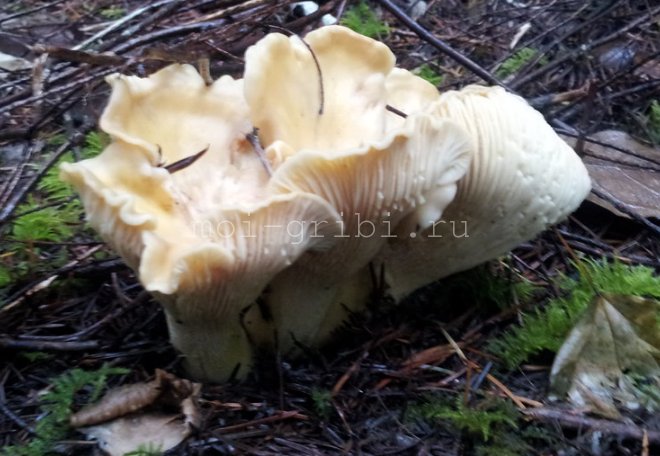
However, there are a lot of benefits you can get from chanterelles.
- This mushroom activates the body's defense systems, thereby enhancing immunity.
- Removes toxins and toxins.
- May inhibit the growth of cancerous tumors.
- Destroys parasites and worms.
- It has a positive effect on blood pressure.
- Treats hepatitis.
- Regulates blood sugar levels.
- Allows you to strengthen the walls of blood vessels.
- Hepatic function is normalized.
- The work of the heart improves.
- The work of the thyroid gland improves.
- The broth helps to treat colds and sore throats.
- Eyesight improves.
- The chanterelle allows you to pull out abscesses and boils.
- Reduces weight.
However, before using this or that prescription in the form of treatment, you need to consult with your doctor. Unfortunately, chanterelles that have been improperly cooked or picked up can only harm your health.
Beneficial features
Chanterelles are popular with mushroom lovers. But apart from their taste, they are valued for their beneficial properties. They contain a lot of carotene, which provides the bright color of the mushroom, there are also other useful substances.
In chanterelles, more than in other mushrooms, manganese, about 1/5 of the daily value required by the body. There is also a high content of vitamins:
- PP ¼ of the daily value in a raw product;
- A - about 15%;
- beta-carotene - 17%.
It contains the necessary:
- trace elements: selenium, zinc, copper;
- macronutrients: phosphorus, sulfur, calcium.
But there are some substances that make this mushroom special:
For those who are limiting their calorie intake, chanterelles will be a godsend.
100 g of chanterelles contains:
- 19 kcal;
- 1.5 g of proteins;
- 1 g of fats and carbohydrates;
- 7 g dietary fiber.
These mushrooms are good for digestion and are quite appropriate in the diet of those on a diet. It contains 89% water, therefore, during the preparation process, they decrease in volume by 3-4 times.
Taste qualities of light chanterelle
Although these chanterelles are called "pale", like pale toadstools, this name should not be deterred, these mushrooms have nothing to do with poisonous species. White chanterelles belong to the 2nd category of edibility.
Light chanterelles, like other members of the family, can be boiled, stewed, fried and salted. Interestingly, the fruit bodies of white chanterelles are never wormy.
Similar species
In appearance, the white chanterelle resembles a false chanterelle.But the color of the false chanterelle is rich orange, its plates are often located, and the leg is very thin and hollow. The false chanterelle belongs to the category of poisonous mushrooms.

Useful properties of white chanterelles
Tinctures are made from white chanterelles, extracts and powders. Chanterelles help remove radioactive substances from the body. These mushrooms are very effective against helminths. Extracts from chanterelles are successfully used to treat liver diseases and hepatitis C. Also, with the help of tinctures, abscesses, furunculosis, sore throats are treated.
With regular use of chanterelles, eyesight improves. Since chanterelles have a low calorie content and at the same time have excellent taste, they can be used to combat the problem of excess weight. In addition, chanterelles contain a large amount of protein.

Other mushrooms of this genus
There are about 60 species of chanterelles in nature:
• Common chanterelle is the most widespread and respected species. It is common chanterelles that are considered the most nutritious and healing. This is a very common variety. Common chanterelles grow in coniferous and deciduous forests. They are found in huge numbers;
• Chanterelle clavate has a pleasant taste. Fruiting of these mushrooms begins in the summer and ends in late autumn. Clavate chanterelles grow mainly in deciduous forests. You can find them in grass or moss;
• Amethyst Chanterelle - a tasty and healthy mushroom that helps to strengthen the immune system. These mushrooms begin to bear fruit in June and continue until October. They grow in the wooded areas of our country. Amethyst chanterelles prefer not too thickened forest areas. They often form mycorrhiza with pines, birches, oaks, beeches and spruces. This variety bears fruit en masse, they are found in circles, rows and colonies;

• Black chanterelle is a conditionally edible mushroom, a related species of the real chanterelle, but outwardly they are completely different. This is a soot-colored mushroom with no characteristic wrinkles on the outside. Black chanterelles grow from July to September, with a peak in August. They are found in deciduous and mixed forests. These mushrooms are found infrequently;
• Humpbacked chanterelle is a conditionally edible mushroom that is found quite abundantly. Humpback chanterelles grow in mixed and coniferous forests, they are found in mossy places. They bear fruit from August until the first cold weather;
• Tubular chanterelle - edible species. These mushrooms begin to bear fruit abundantly in August and are found until October. They prefer mixed and coniferous forests. Tubular chanterelles settle in large colonies. Their favorite habitats are acidic soils.

Types of chanterelles photo and description
Most species of chanterelles are edible. There are more than 60 species of chanterelles, there are no poisonous ones, but there are inedible species - a false chanterelle, for example.
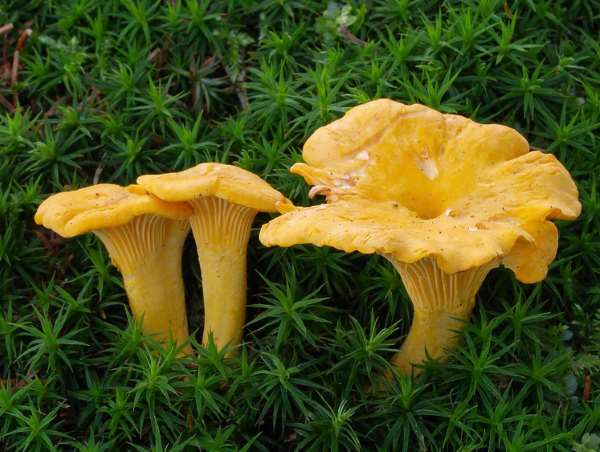
Common chanterelle
- an edible mushroom. The hat is 2-12 cm in diameter. Mushrooms with fleshy flesh, yellow at the edges, and white at the cut. Common chanterelle tastes sour. Grows in coniferous and deciduous forests from June to October.

Chanterelle gray
- an edible mushroom. The color of the chanterelle is from gray to brown-black. A hat with a diameter of up to 6 cm, with wavy edges and a depression in the center, edges are ash gray.
Elastic gray flesh, with an inexpressive taste and no aroma.
The gray chanterelle grows in deciduous forests from June to October. This species is little known to mushroom pickers, they avoid it.
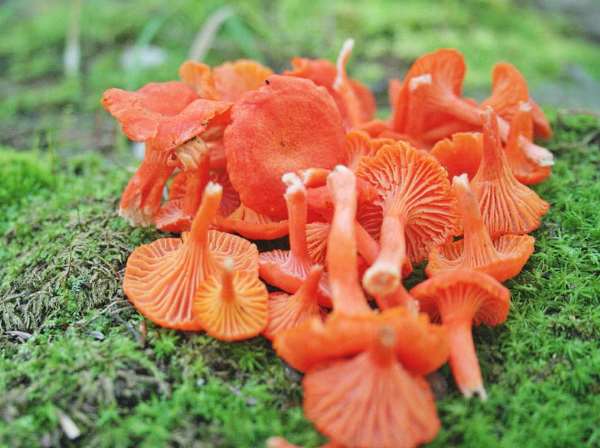
Cinnabar red chanterelle
- an edible mushroom. The color of the chanterelle is reddish or pinkish red. A hat with a diameter of up to 4 cm, a leg up to 4 cm high. The flesh is fleshy with fibers. The hat is concave towards the center with jagged, curved edges. You can find the cinnabar red chanterelle in the oak groves in eastern North America. Mushroom picking takes place in summer and autumn.
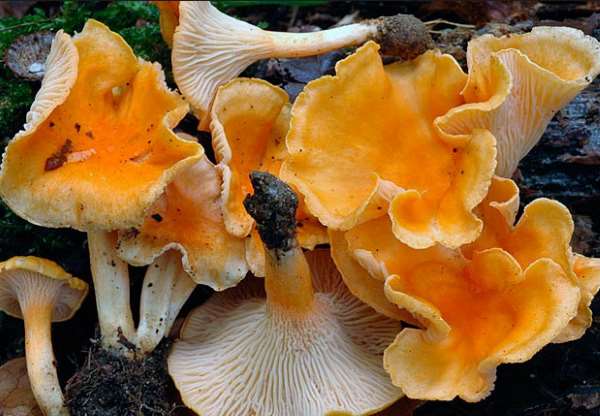
Chanterelle velvety
- a rare, edible mushroom. The cap is orange-yellow or reddish, up to 5 cm in diameter, convex in shape, becomes funnel-shaped over time.The pulp is light orange with a pleasant smell. The velvety chanterelle grows in deciduous forests of eastern and southern Europe on acidic soils. This mushroom is harvested from July to October.

Chanterelle yellowing
- an edible mushroom. The hat is up to 6 cm in diameter, yellowish-brown in color, covered with scales. The cut pulp is beige, tasteless and odorless. It can be found in coniferous forests, on moist soils during the summer.
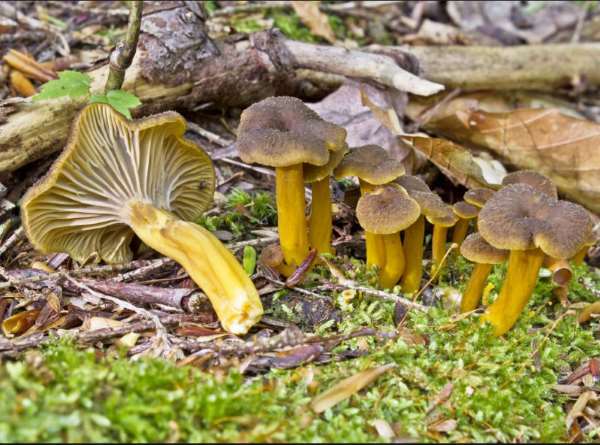
Tubular chanterelle
- an edible mushroom. The hat is up to 8 cm in diameter, funnel-shaped with uneven edges, grayish-yellow in color. The pulp is dense, white at the cut, has a pleasant smell of earth and has a bitter taste. It grows mainly in coniferous forests.

Chanterelle Cantharellus minor
- similar to the common chanterelle, an edible mushroom. The cap is up to 3 cm in diameter, orange-yellow in color, with wavy edges. The pulp is soft, brittle, yellow in color. Such a chanterelle grows in the oak forests of North America.
Quinomannose tablets
17 left in stock
- + Buy
The course of treatment is: 30 days
The required quantity of goods is 3 pcs.
Next shipment date 20.10.2019... You can find out more about the cost and terms of delivery here.
Delivery by post of the Russian Federation from 250 rubles. Delivery to CDEK pick-up points from 270 rubles.
NUMBER OF PERFORMED PURCHASES: 2579
Do you doubt it? Ask your friends:
Chanterelle mushroom is an excellent remedy for cleaning the body
Nature has given people an amazing gift: a variety of mushrooms have appeared on our planet, many of which have miraculous properties. Since ancient times, healers have tried to comprehend the secrets that mushrooms keep in themselves, prepared medicines from them, discovering more and more new useful properties.
Chanterelle, a mushroom that everyone knows - it is difficult to confuse it with other mushrooms. The chanterelle is also a medicinal mushroom, and its properties are very specific - it is these properties that determine its amazing clean pulp - without wormholes and larvae.
And all because in the spores and pulp of this mushroom there is a unique substance - quinomannose, which is not tolerated by helminths of all types.
How to properly treat mushrooms and where to find them
Fungotherapy (in other words, mushroom treatment) has now become widespread, thanks to a number of studies and amazing discoveries, as well as the promulgation of interesting facts that were known to oriental healers in ancient times. Many people mistakenly believe that absolutely any edible mushroom can be treated, but this is not the case.
For these purposes, only certain mushrooms with pronounced medicinal properties are suitable. To prepare preparations from such mushrooms, considerable experience and certain knowledge are required, which are available only to real professionals.
Do not trust dubious individuals who offer wonderful powders; buy mushroom preparations only from trusted manufacturers. All drugs offered by this center have passed all the necessary clinical trials, fully meet sanitary standards and are safe for people.
Back to the beneficial properties of the Chanterelle mushroom
It is worth highlighting several main areas:
Fight against parasites - quinomannosis is an absolutely natural substance that does not and cannot cause side effects.
The action of this substance is fundamentally different from synthetic anthelmintic drugs: it does not poison the helminths, but penetrates into the mucous membrane and causes blockage of the nerve centers of the helminths, as a result of which there is no damaging effect of human vital organs.
Unlike anthelmintic drugs, quinomannosis perforates, that is, partially dissolves the shells of the eggs of the worms, thereby destroying numerous clutches of eggs of helminths.
Restoration of the liver - the substance ergosterol effectively affects liver enzymes in the West, pure ergosterol is used for complex liver cleansing.
And finally, recent studies have shown that the trametonolinic acid contained in mushrooms has a successful effect on the hepatitis virus, therefore, Chanterelles are indicated for diseases such as Hepatitis and Liver cirrhosis.
Scientists have found that Chanterelles help in the treatment of:
- Sore throats,
- Allergy,
- Boils and abscesses,
- Obesity,
- Excellent fight against tuberculosis bacillus,
- Diseases associated with vision "Night blindness".
How to use Chanterelles
Preventive course: 3 capsules 3 times a day, with meals.
Course duration: 3-4 weeks. You will need 3-4 jars of Chanterelle mushroom. Treatment is desirable in early spring and early autumn.
Packaging of the drug
60 capsules 270 mg each - concentrated extract of the Chanterelle mushroom
The information on this page may be out of date, incomplete and copied from other sites.
All scientific information that I constantly supplement (the results of world experimental and clinical studies) is posted here
Latin name: Cantharellus cibarius
It is used when:
- infection of the body with parasites and parasitic diseases
- chronic hepatitis, liver cirrhosis, hemangioma
- eye diseases
Chanterelles are valuable mushrooms due to several polysaccharides they contain - chitinmannose, ergosterol and trametonolinic acid. Chitinmannosis is a natural anthelmintic, so the chanterelle helps to easily get rid of any helminthic invasions.
The second active substance of chanterelles is ergosterol, which effectively acts on liver enzymes. Therefore, chanterelles are useful for liver diseases such as hepatitis, fatty degeneration, hemangiomas.
Recent studies have shown that trametonolinic acid is effective against hepatitis viruses.
Time and place of fruiting
The time for the fruiting of the mushroom in the middle latitudes of Russia is the period from early June to late July, as well as all August until late October. Cantarellus yellow lives mainly in coniferous and mixed forests, but also occurs on birch edges. Its mycelium loves soils where spruce, beech, oak and pine grow. Usually these are areas covered with grass, moss or fern, where there is enough moisture and shaded areas. It grows in groups on the ground, often with the formation of witch circles, in conditions of moderate humidity.
Common chanterelle is considered an unpretentious fungus that does not deteriorate in drought and wet seasons. The first wave of the harvest appears after thunderstorms in late May. It takes 6-9 days for the mushrooms to grow their bodies. The second harvest season begins after the autumn fogs. Warm sunny weather and rains are the main conditions for ripening in the summer-autumn period.
Do not forget that the flesh of chanterelles, like a sponge, absorbs radioactive isotopes, salts of heavy metals and other toxins. Therefore, only young fruits with a diameter of no more than 10 cm are cut off. The collection of mushrooms necessarily takes place far from factories and trails. The most useful and tasty chanterelles, juicy, without a “rubbery” aftertaste, are harvested in summer. The autumn harvest is perfect for conservation and freezing.
Few regions of Russia are considered to be the fruiting area of Cantarellus yellow. This valuable mushroom is listed in the Red Book of a number of regions: the Murmansk and Pskov regions, the Yamalo-Nenets Autonomous District, the Khabarovsk Territory. There is a fine for collecting it. In other regions, the cut of the fruits of the mycelium should be carried out in accordance with the provisions of the Forest Code and taking into account the control of the land by non-departmental units.
You should also be careful when collecting mushrooms with the whole family - a child can easily pick a false chanterelle. And since the picking of fruits is quick (they do not need to be cleaned, the legs are already cut off), the “toadstool” may not be noticed.
Characteristics and description of tubular mushroom
In special literature or on the Internet, it is found under the name "Twisty funnel".In the people, however, it is called very differently: the "cornucopia", and the "pipe of death", and simply "gray mushroom."
The sight of a gray chanterelle is very unattractive. The body of the mushroom has a corresponding color with a brown tint. The hat is a funnel with carved edges bent upwards, which can grow up to 8 cm. From the bottom it narrows, turning into a short stem. In an adult specimen, white spores can be found on the cap, it seems to be sprinkled with them. The pulp of the mushroom is black, with a light aroma. Despite the obvious unpopularity among mushroom pickers and cooks, the gray chanterelle is listed in the Red Book of Ukraine and Belarus.
A bit of history
In the scientific world, the Sinuous Funnel became known from the description of the Dutch mycologist Christian Heinrich Person in 1798. And it got its modern name in the middle of the 19th century thanks to the Swedish researcher and founder of mushroom taxonomy Elias Magnus Fries.
Features, time and place of fruiting
The cornucopia is found during the period of the mushroom harvest, from August to October, in central Russia, in Karelia, in the Ukraine, in Belarus and in northern Europe. For comfortable growth, humid mixed forests are suitable for him, in which oaks and hazel are found. The mushroom grows in groups, forming peculiar bouquets on the surface of the earth, its bunches in shape resemble bizarre inflorescences. Due to the ash-gray color, this type of chanterelles in fallen and withered foliage is not immediately noticeable even to attentive mushroom pickers.
Description
The chanterelle is the most famous and most common of the 60 species that make up the genus Chanterelle (Chanterelle family).
The mushroom has a short (4-6 cm), smooth, slightly narrowed to the base of the leg. It is dense to the touch.
The leg is firmly fused with the cap. In young fungi, the "headdress" is almost flat with a curved edge. Over time, the cap takes the shape of a funnel with irregular outlines. The edges become uneven, torn in places. Rare, branched pseudo-plates pass from the seamy surface of the cap to the leg. The diameter of the cap is within 4–6 cm.
The entire fruiting body of Chanterelle vulgaris is light yellow or orange-yellow. Often there are specimens that have burned out almost to whiteness. Only overripe chanterelles are bright orange. It is better to bypass them.
The pulp of the mushroom is dense. From above it is yellowish, closer to the center - whitish. A slight fruity aroma is felt when cut / fractured.
The common chanterelle is never wormy. Mushroom mosquitoes and flies are deterred by hinomannosis, so they prefer to lay their eggs elsewhere. If the mushroom rots by chance, then the decay point is always in sight. This feature saves you from disappointment when processing the crop.
False doubles
A false one is very similar in shape to a white chanterelle, or an orange talker, but it is completely different in color, it is brighter. At the same time, the toxicity of the second causes considerable controversy and doubts among scientists around the world. In different countries, it is ranked among more or less edible mushrooms, but a possible hallucinogenic effect is noted. An unpleasant smell and taste makes you refuse to use it.
 Orange talker
Orange talker
The bent talker looks like a pale chanterelle more in color, but the mushroom has an almond smell, there is a tubercle in the center. It is edible. The photo shows their difference.
 Bent talker
Bent talker
In general, chanterelles are difficult to confuse with other mushrooms, they have a special shape of the cap and legs. And white is unique for its unusual color, although it can acquire a yellow tint in the rain, and after drying it returns to its previous color.
Description and photo of a white chanterelle
Chanterelle is an edible mushroom. How to understand that it was her you found in the forest? To do this, you need to accurately navigate the description of this mushroom.
Consider what you need to pay attention to first.
Hat
The hat is the first thing the mushroom picker pays attention to. And here the chanterelle is difficult to confuse with anything
In diameter, it reaches from 1 to 5 cm.This variation mainly depends on the age of the fungus, as well as on the surrounding environment, moisture and soil nutrition. Sometimes you can find fruiting bodies with a cap diameter of 8 cm. However, this is an exception rather than a rule, the soil around is probably very fertile.
If you look at the distinctive features of the chanterelle, then the differences can be attributed to the winding edge along the contour of the cap. Also, the mushroom is not convex to the center, like many others, but on the contrary, bends inward, like a funnel.
If you look at young chanterelles, you will notice that the edges of their caps are relatively even. However, with age, the edges begin to bend downward, because of this, a wave is created.

The Pale Chanterelle has its own significant difference from all other chanterelle family due to its shade. If the chanterelles we are used to are bright yellow, even slightly orange, then this is a representative of white or beige tones. Also, blurred spots of various yellow shades can be found on the cap. They are located randomly.
Under the hat there are stripe compartments in which spores hide.
Leg
As for the stem of this mushroom, it is very thick and has a pale yellowish tint. On the cut, it is white and does not darken when exposed to oxygen. The leg height varies from 2 to 5 cm, depending on age and growing conditions. The thickness of the stem reaches one and a half cm. It is interesting that the stem of the mushroom consists of two parts at once. Subdivided into top and bottom. The lower part has a cylindrical shape and looks a bit like an old Russian mace. The upper part of the leg is tapered and tapers strongly towards the lower part.
In the upper part of the leg, you can see the adherent plates, in which the spores are hidden. They sit quite tightly and the leg is difficult to separate from the cap.
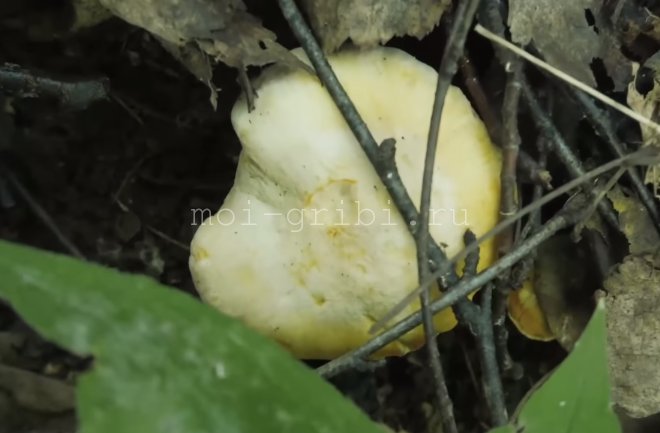
Edibility of the white chanterelle
Chanterelle light - edible mushroom. We have established this in the paragraphs above. It belongs to the second category of edibility. What does this mean? Maybe it's better not to collect these representatives of the mushroom kingdom, so as not to touch the consequences?
Despite the fact that the mushroom itself bears a frightening name, which for some reason many associate with “pale toadstool”, a very poisonous mushroom, the white chanterelle never poses a danger to human health. But only on condition that you collect fresh mushroom without traces of visible damage. This mushroom is not only tasty, but also healthy. He has very good taste, which is in no way inferior to ordinary chanterelles. You will surely like the characteristic mushroom smell.

However, be careful. If you notice that the light chanterelle has uncharacteristic dark spots, its fruit body has become viscous and withered, or vice versa dry, and there are holes in the fruit body that worms probably made, then it is better not to touch this mushroom. It is not edible. Unfortunately, if the fruit part is damaged, the fungus may release not the most useful substances that, when interacting with oxygen, will be harmful to humans. They will not bring serious damage to health, however, you will be provided with a slight poisoning or indigestion. In general, pick only young and healthy mushrooms.
Where it grows and when to collect the pale chanterelle
Unfortunately, on the territory of Russia and the CIS countries, this mushroom is quite rare. Most of all he loves deciduous forests, high humidity.
They settle near water bodies and love shady areas.
It does not tolerate direct exposure to sunlight, because its delicate skin cracks under strong radiation.

These mushrooms grow in groups, like other representatives of the chanterelle family. The main fruiting period is from June to September. In June you can find very small mushrooms, but in September the chanterelles will delight you with their size.
It is best to pick mushrooms in forests with moss or grass bedding. It is here that the soil is saturated with useful vitamins and nutrients for mushrooms, so they grow tasty and healthy.
They are located mainly in the central zone of Russia, on the territory of Ukraine and Belarus.
But in the European part they are found in Germany, Poland and France.
Therefore, even if last year at a certain place you found a good harvest of white chanterelles, it is far from a fact that this year you will be pleased with the same abundance.
Why are chanterelles bitter, how to remove bitterness?
Chanterelles have natural bitterness
, therefore, pests and insects do not like them, but they are appreciated in cooking. If the mushrooms are not processed immediately after harvesting, the bitterness will increase. Also, an increase in the bitterness of chanterelles is possible due to the influence of some natural factors.

More bitterness in chanterelles
collected in dry weather, under coniferous trees, next to tracks and businesses, overgrown mushrooms growing in moss, if these are false chanterelles.
It is better to collect and cook young chanterelles, the bitterness content in them is minimal. To remove the bitterness, you need to soak the chanterelles for 30-60 minutes in water, then boil. Drain the water after cooking.
For freezing, use boiled chanterelles - they will not taste bitter and take up less space. If you have frozen fresh and defrosting found that the mushrooms are bitter, boil them in salted water, the bitterness will go into the water.
Cooking recipes
So, if you are lucky and you have collected a whole basket of white chanterelles, it's time to cook delicious dishes from them. After all, it is in their fresh form that they are very good, and also have all the necessary set of useful properties.
What recipes should you pay attention to?
Fried chanterelles
- You need to pre-process the mushrooms. They are well washed with water, all dried or foreign elements are removed.
- Dry with a towel.
- Then, the chanterelles are cut exactly in half. Too large mushrooms in four pieces.
- A frying pan is heated, and onions are fried on it.
- Next, after 2-3 minutes, you need to throw the mushrooms and fry for about 5 minutes, stirring constantly.
- Season with salt and pepper to taste.
- Then add a little sour cream and simmer the chanterelles for 10 minutes.
You will get a very tasty addition to the main course.
Chanterelle salad
You will need some onions, eggplant, cheese, butter and milk. The rest of the products are added as you wish.
- First you need to make the sauce. For this, milk and cream are combined and heated in a water bath. Parmesan is added to it and everything is whipped with a blender.
- Meanwhile, chanterelles are fried with onions. Parsley and tomatoes are also added there.
- Eggplants are cut at random.
- Parmesan is rubbed on a coarse grater.
- All ingredients are combined and filled with sauce.
How much to cook a white chanterelle?
If you need a boiled mushroom, then in this case, you need to cook it correctly
It is important to strike a balance here. An undercooked chanterelle may respond to you with not the most pleasant taste and consequences.
And the overcooked mushroom will simply fall apart, and its taste properties will not be preserved.
So, how to cook a chanterelle properly?
If the mushroom is small, that is, its cap is about 5 cm in diameter, then in this case it should be thrown immediately into boiling water. At the same time, you need to cook it for 5 minutes. This will be enough to achieve the desired effect.
But if the mushroom is large enough, the cap reaches about 8 cm in diameter, then you are advised to cook for 10 minutes. This is quite enough to achieve good results.
How to cook soup?
If you need to cook soup, you need to follow this method.
Put the water to boil. You can pre-cook the broth.
Then, the chopped potatoes, carrots, onions and other vegetables you need are placed in the pan. By the way, broccoli goes well with chanterelles.
Then, 10 minutes before readiness, chanterelles are placed in the soup, cut in half or into quarters, depending on their size. Boil for 10 minutes, after which the soup is salted, pepper is added and it is removed from the heat. Top with parsley. It turns out very tasty.
Chanterelles are peaceful forest dwellers who delight us not only with their deliciousness, but also with their appearance.
In order to get real pleasure from their use, it is important to be able to distinguish chanterelles from other representatives of forest dwellers. And in this case, you will surely be pleased with the contents of your basket.



